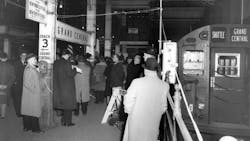June 23, 1939, was a key date in New York City subway transit history. NYC Mayor Fiorello LaGuardia announced a final agreement between City Hall and the two private subway owners was reached after several years of negotiations. NYC offered $151 million to purchase all assets of the Interborough and Manhattan Railway and $175 million for the Brooklyn-Manhattan Rapid Transit system.
Today's generation of NYC Transit subway riders and elected officials, for the most part, have no idea that original IRT (Interboro Rapid Transit - 1,2,3,4,5,6,7, Franklin Ave and Times Square shuttles) and BMT (Brooklyn Manhattan Rapid Transit – today’s B,D,J,M, N,Q, R and Z lines) subway systems were constructed and managed by the private sector with no government operating subsidies.
Financial viability was 100 percent dependent upon farebox revenues. They supported both development and economic growth of numerous neighborhoods in the boroughs of Manhattan, Brooklyn, Bronx and Queens. As part of the franchise agreement which owners had to sign, City Hall had direct control over the fare structure. For a period of time, owners actually make a profit with a five-cent fare.
After two decades passed, the costs of salaries, maintenance, power, supplies and equipment would pressure owners to ask City Hall for permission to raise the fares. This additional revenue was needed to keep up with maintaining a good state of repair, increase the frequency of service, purchase new subway cars, pay employee salary increases and support planned system expansion. Politicians more interested in the next reelection (and subscribing to the old Roman philosophy of free bread and circuses) refused this request each year, for well over a decade. In order to survive, owners of both systems began looking elsewhere to reduce costs and stay in business. They started curtailing basic maintenance, delayed purchases of new subway cars, postponed salary increases for employees, canceled any plans for system expansion and cut corners to survive. (Does this sound familiar?)
In the 1930s, NYC began building and financing construction of the new IND (Independent Subway – today’s A,C,E,F and G lines). This new municipal system subsidized by taxpayers dollars would provide direct competition to both the IRT and BMT. Municipal government forced them into economic ruin by denying them fare increases that would have provided access to additional badly needed revenues. Big Brother, just like the Godfather, eventually made them an offer on June 23, 1939 they couldn’t refuse. The owners folded and sold out to City Hall. NYC purchased the IRT for $151 and BMT for $175 million. This resulted in the integration of both systems with the municipal IND system.
In 1953, the old NYC Board of Transportation passed on control of the municipal subway system, including all its assets to the newly created New York City Transit Authority. Under late Governor Nelson Rockefeller in the 60′s, the New York Metropolitan Transportation Authority was created.
-------------------------
Larry Penner is a transportation advocate, historian and writer who previously worked for the Federal Transit Administration Region 2 NY Office. This included the development, review, approval and oversight for billions of dollars in grants which provided funding for capital projects and programs to the NY MTA, NYC Transit, Long Island and Metro North Rail Roads, MTA Bus, NYC DOT, NJ Transit and more than 30 transit agencies in New York and New Jersey.
About the Author

Larry Penner
Larry Penner is a transportation advocate, historian and writer who previously served as a former director for the Federal Transit Administration Region 2 New York Office of Operations and Program Management. This included the development, review, approval and oversight for billions in capital projects and programs for New Jersey Transit, New York Metropolitan Transportation Authority, NYC Transit bus, subway and Staten Island Railway, Long Island and Metro North railroads, MTA Bus, NYCDOT Staten Island Ferry along with 30 other transit agencies in New York and New Jersey.
